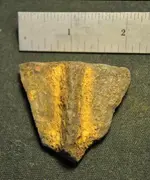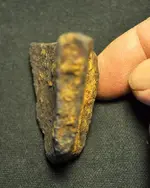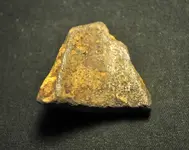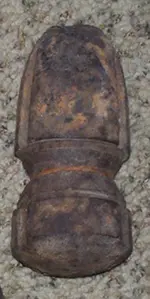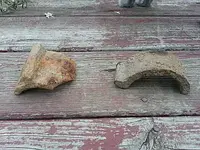You are using an out of date browser. It may not display this or other websites correctly.
You should upgrade or use an alternative browser.
You should upgrade or use an alternative browser.
✅ SOLVED [B]Civil War Projectile Frag - Schenkel? Hotchkiss?[/B]
- Thread starter macrota
- Start date
recondigger
Bronze Member
- Joined
- Jul 12, 2012
- Messages
- 1,223
- Reaction score
- 900
- Golden Thread
- 1
- Location
- Western New York
- 🥇 Banner finds
- 1
- Detector(s) used
- garrett at4 beach hunter, bounty hunter,CZ-5,CZ-7, Minelab EXP SE, Garrett ACE-150, E-Trac, CTX 3030
- Primary Interest:
- All Treasure Hunting
Cannonball would be able to tell you.
Scouts out!
Scouts out!
Upvote
0
TheCannonballGuy
Gold Member
- Joined
- Feb 24, 2006
- Messages
- 6,607
- Reaction score
- 13,455
- Golden Thread
- 0
- Location
- Occupied CSA (Richmond VA)
- Detector(s) used
- White's 6000, Nautilus DMC-1, Minelab
- Primary Interest:
- Relic Hunting
Welcome to the What-Is-It forum.
Unfortunately I have to tell you that the object is definitely not an artillery shell fragment. It is a broken piece of a tapered-thickness heavy iron half-ring (or band) which has been seen several times in this forum but has not yet been identified. See the photo below, showing a previous one very similar to yours, on the left in the photo.
Civil war era Schenkl projectiles had several raised ridges running along the axis of their "tail" section, but those ridges are always flat-topped, and are not as "tall" as the ridge seen on your iron object. What you are seeing in the photo of a civil war Hotchkiss shell is a groove, not a ridge.
Unfortunately I have to tell you that the object is definitely not an artillery shell fragment. It is a broken piece of a tapered-thickness heavy iron half-ring (or band) which has been seen several times in this forum but has not yet been identified. See the photo below, showing a previous one very similar to yours, on the left in the photo.
Civil war era Schenkl projectiles had several raised ridges running along the axis of their "tail" section, but those ridges are always flat-topped, and are not as "tall" as the ridge seen on your iron object. What you are seeing in the photo of a civil war Hotchkiss shell is a groove, not a ridge.
Attachments
Upvote
0
TheCannonballGuy
Gold Member
- Joined
- Feb 24, 2006
- Messages
- 6,607
- Reaction score
- 13,455
- Golden Thread
- 0
- Location
- Occupied CSA (Richmond VA)
- Detector(s) used
- White's 6000, Nautilus DMC-1, Minelab
- Primary Interest:
- Relic Hunting
Leg shackles don't have a tapered thickness.
Also, leg shackles were made of wrought iron, a form of iron which bends instead of shattering. Your broken object is a shattered piece of cast iron, a form of iron which is too brittle to bend, and instead, it shatters when sufficient force is put upon it. That is why explosive shells prior to the end of the 1800s were made of cast iron, and since then are made of cast steel. You WANT them to shatter into multiple fragments.
Also, leg shackles were made of wrought iron, a form of iron which bends instead of shattering. Your broken object is a shattered piece of cast iron, a form of iron which is too brittle to bend, and instead, it shatters when sufficient force is put upon it. That is why explosive shells prior to the end of the 1800s were made of cast iron, and since then are made of cast steel. You WANT them to shatter into multiple fragments.
Upvote
0
macrota
Greenie
- #6
Thread Owner
TheCannonBallGuy,
Thanks for your help and replies. Glad to have you around. I was a fossil hunter for 25 years and recently switched to metal detecting. Relic hunting is what I enjoy and it's a heck of a lot easier than digging and sifting clay layers.
Best,
macrota
(macrota is the species name for Striatolamia macrota - a shark that swam the oceans 50-million-years ago
Thanks for your help and replies. Glad to have you around. I was a fossil hunter for 25 years and recently switched to metal detecting. Relic hunting is what I enjoy and it's a heck of a lot easier than digging and sifting clay layers.
Best,
macrota
(macrota is the species name for Striatolamia macrota - a shark that swam the oceans 50-million-years ago
Upvote
0
TheCannonballGuy
Gold Member
- Joined
- Feb 24, 2006
- Messages
- 6,607
- Reaction score
- 13,455
- Golden Thread
- 0
- Location
- Occupied CSA (Richmond VA)
- Detector(s) used
- White's 6000, Nautilus DMC-1, Minelab
- Primary Interest:
- Relic Hunting
Macrota wrote:
> Thanks for your help and replies. Glad to have you around.
Macrota, you said you are new to metal-detecting for relics. I'm here to help people like you in the What-Is-It forum because back when I was new to this hobby, a couple of kindhearted "oldtimer" experts gave me a LOT of their time helping me identify my finds. I'm doing for others what those guys did for me. Someday it will be your turn to do that.
> Thanks for your help and replies. Glad to have you around.
Macrota, you said you are new to metal-detecting for relics. I'm here to help people like you in the What-Is-It forum because back when I was new to this hobby, a couple of kindhearted "oldtimer" experts gave me a LOT of their time helping me identify my finds. I'm doing for others what those guys did for me. Someday it will be your turn to do that.

Upvote
0
Similar threads
- Replies
- 14
- Views
- 778
- Question
- Replies
- 5
- Views
- 751
Users who are viewing this thread
Total: 1 (members: 0, guests: 1)

